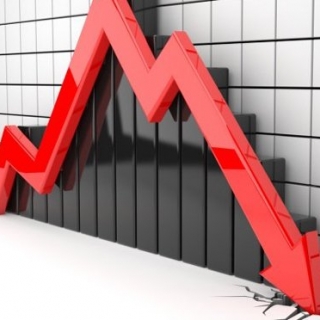


Stocks sold off on Friday as fresh U.S. data fueled investor concerns about a slowing economy and high inflation, sending them seeking safer assets.
The losses deepened as traders worried about a weekend that could bring another barrage of headlines from the Trump administration, which has proposed a series of tariffs and other market-moving policy changes since taking office a month ago.
The Dow Jones Industrial Average fell 724 points, or 1.6%, bringing its two-day loss to more than 1,200 points. Friday's loss was its biggest of the year. The S&P 500 traded 1.6% lower, falling for a second day after closing at a record on Wednesday. The Nasdaq Composite fell more than 2%.
A slew of economic data raised fresh concerns about the economy and sent investors into bonds, sending yields tumbling. The University of Michigan's consumer sentiment index fell to 64.7 in January, a 10% drop and a sharper decline than expected as consumers voiced concerns about higher inflation from possible new tariffs. The survey's five-year inflation outlook was 3.5%, the highest since 1995. Additionally, U.S. existing home sales fell more than expected last month to 4.08 million units. The U.S. services purchasing managers' index also fell into contraction territory for February, according to S&P Global.
Walmart shares fell for a second day after the company issued a weaker-than-expected forecast that also soured the outlook for consumers and the economy.
Prominent investor Steve Cohen offered some negative comments on the market and economy from a conference in Miami.
"This is clearly a period where I think the best gains have been made and [I] wouldn't be surprised to see a significant correction," Cohen said, citing proposed tariffs that are dragging on the economy, as well as some government cost-cutting efforts.
Investor favorites such as Nvidia and Palantir suffered sharp losses Friday as they moved into traditionally safer assets. Procter & Gamble rose more than 1%, while General Mills and Kraft Heinz each gained more than 2%.
For the week, the S&P 500 is down about 1.6%, while the Dow and Nasdaq are down 2.5% and 2.4%, respectively.
"The top 20 performers in the S&P 500 today are all from defensive sectors: consumer staples, utilities and health care," said Larry Tentarelli, chief technical strategist and founder of the Blue Chip Daily Trend Report. "Investors often turn to these so-called defensive sectors when economic growth concerns arise." (Newsmaker23)
Source: CNBC
Asia-Pacific stock markets are expected to open mixed on Friday, marking a cautious start to the new year. This movement follows the New Year's Eve close of US markets, where the three major Wall Stre...
European stocks ended mixed on the last trading day of the year. The pan-European Stoxx 600 index closed a shortened trading session 0.1% lower on Wednesday, with most sector indexes in negative terr...
Stocks were little changed Wednesday as Wall Street got ready to close out a bumper year for equities. Stocks are riding a three-session losing streak, although the declines have been mild and the S&...
Happy New Year 2026 Newsmaker.id...
European equities traded at all-time highs on the final day of 2025, setting the stage for their strongest year since 2021, driven by gains in banks and miners. The STOXX 50 rose 0.5% to near a record...
Asia-Pacific stock markets are expected to open mixed on Friday, marking a cautious start to the new year. This movement follows the New Year's Eve close of US markets, where the three major Wall Street indexes weakened, although overall they still...
Gold prices rose in early Asian trading amid growing geopolitical concerns in the Middle East. This increase occurred as tensions between Saudi Arabia and the United Arab Emirates escalated in recent days, prompting investors to seek safe haven...
World oil prices stabilized on the first trading day of 2026 after experiencing a sharp decline throughout last year. West Texas Intermediate (WTI) crude traded above US$57 per barrel, while Brent, the global benchmark, closed below US$61 per...
 The US Federal Reserve agreed to cut interest rates at its December meeting only after a highly nuanced debate about the current risks facing the US...
The US Federal Reserve agreed to cut interest rates at its December meeting only after a highly nuanced debate about the current risks facing the US...
 European stocks picked up steam on Tuesday, extending gains to notch a fresh record high.
The pan-European Stoxx 600 index provisionally closed...
European stocks picked up steam on Tuesday, extending gains to notch a fresh record high.
The pan-European Stoxx 600 index provisionally closed...
 US stocks held their muted momentum on Tuesday, set to close the year relatively near recent record highs as markets assessed the outlook of robust...
US stocks held their muted momentum on Tuesday, set to close the year relatively near recent record highs as markets assessed the outlook of robust...
 Geopolitical tensions in Latin America are escalating again, particularly regarding Venezuela and pressure from US policies. This situation has...
Geopolitical tensions in Latin America are escalating again, particularly regarding Venezuela and pressure from US policies. This situation has...